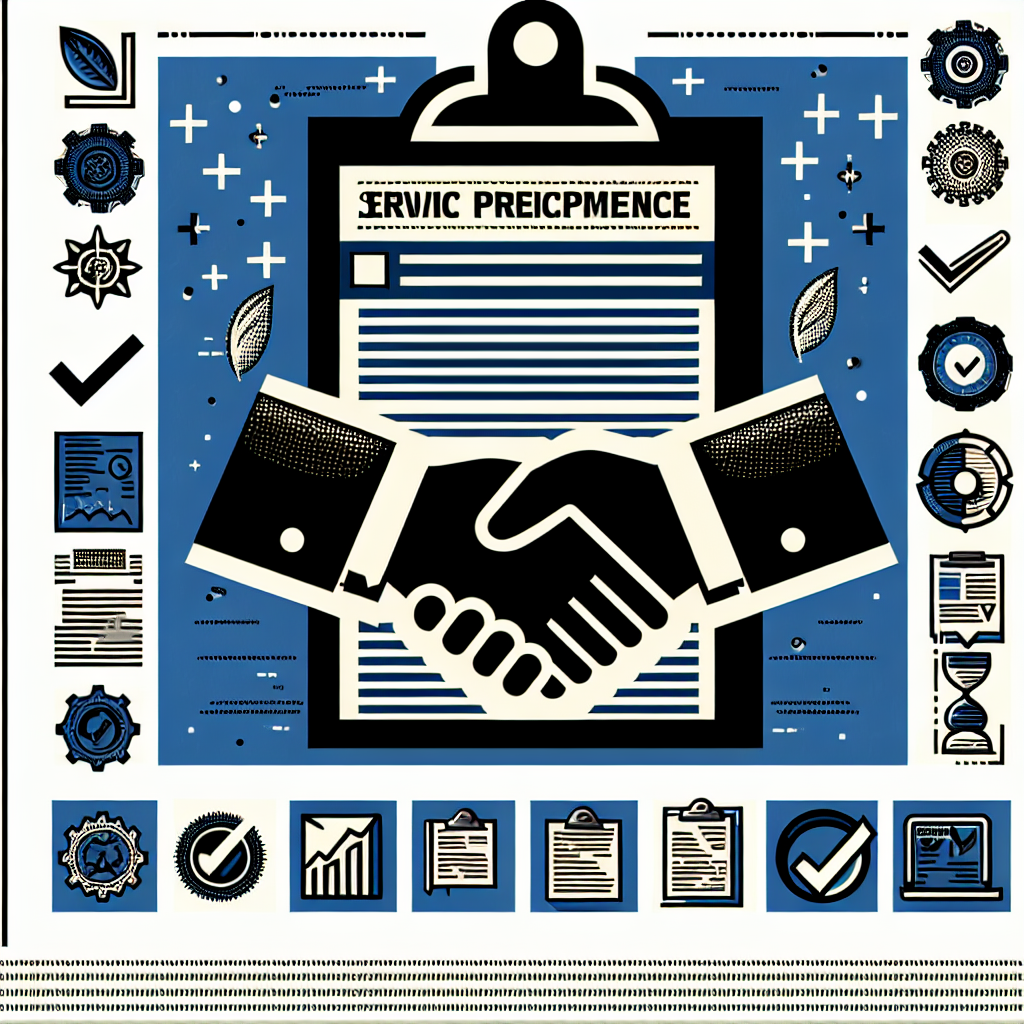Your cart is currently empty!
Tag: Agreements

Ensuring Compliance with Service Level Agreements: Best Practices for Businesses
Service Level Agreements (SLAs) are essential contracts that establish the expectations and responsibilities between a service provider and its customers. Ensuring compliance with SLAs is crucial for businesses to maintain customer satisfaction, build trust, and uphold their reputation. Here are some best practices for businesses to follow in order to ensure compliance with SLAs:1. Clearly Define and Communicate SLAs: The first step in ensuring compliance with SLAs is to clearly define the terms and conditions of the agreement. This includes outlining the services to be provided, performance metrics, response times, and escalation procedures. It is important to communicate these SLAs to all relevant stakeholders, including employees, customers, and third-party vendors.
2. Monitor Performance Metrics: Monitoring performance metrics is essential for tracking progress and identifying any potential issues or deviations from the SLA. Businesses should regularly measure key performance indicators such as response times, uptime, and resolution rates to ensure that they are meeting the agreed-upon service levels. This data can help businesses identify areas for improvement and make necessary adjustments to meet SLA requirements.
3. Implement Service Level Management Tools: Utilizing service level management tools can help businesses automate and streamline the monitoring and management of SLAs. These tools can track service levels in real-time, generate reports, and provide alerts for any deviations from the agreed-upon levels. By implementing these tools, businesses can proactively manage SLAs and address any issues before they impact customer satisfaction.
4. Establish a Feedback Loop: Establishing a feedback loop with customers is essential for ensuring compliance with SLAs. Businesses should regularly solicit feedback from customers to gauge their satisfaction with the services provided. This feedback can help identify areas for improvement and ensure that businesses are meeting customer expectations. In addition, businesses should communicate any changes to SLAs to customers in a timely manner to maintain transparency and trust.
5. Conduct Regular SLA Reviews: Businesses should conduct regular reviews of SLAs to assess their effectiveness and make any necessary adjustments. These reviews should involve all relevant stakeholders, including customers, employees, and third-party vendors. By regularly reviewing SLAs, businesses can ensure that they are meeting customer expectations and making any necessary improvements to their service levels.
In conclusion, ensuring compliance with SLAs is essential for businesses to maintain customer satisfaction and build trust with their customers. By following these best practices, businesses can effectively manage SLAs, monitor performance metrics, and proactively address any issues to meet customer expectations. By establishing clear communication, utilizing service level management tools, and conducting regular reviews, businesses can ensure compliance with SLAs and uphold their reputation in the marketplace.

Measuring Success: Using Key Performance Indicators in Service Level Agreements
Measuring Success: Using Key Performance Indicators in Service Level AgreementsIn today’s competitive business landscape, it is essential for companies to not only meet their customer’s expectations but to exceed them. One way to ensure this is by implementing key performance indicators (KPIs) in service level agreements (SLAs) to measure the success of service delivery.
KPIs are quantifiable metrics that help companies gauge their performance and progress towards achieving their goals. By incorporating KPIs into SLAs, companies can establish clear expectations, measure performance, and identify areas for improvement.
When developing an SLA, it is important to identify the key metrics that are most relevant to the service being provided. For example, in a customer service SLA, KPIs may include response time, resolution time, customer satisfaction scores, and first-call resolution rates. These metrics can help companies track their performance in real-time and make adjustments as needed to meet and exceed customer expectations.
By using KPIs in SLAs, companies can also hold service providers accountable for their performance. If a service provider consistently fails to meet KPI targets, it may be grounds for renegotiating the terms of the SLA or even terminating the agreement altogether. This ensures that companies are receiving the level of service they are paying for and helps maintain a high standard of quality.
Furthermore, KPIs can also help companies identify trends and patterns in their service delivery. By analyzing KPI data over time, companies can identify areas where they are excelling and areas where they may need to make improvements. This data-driven approach to performance management can help companies make informed decisions and drive continuous improvement in their service delivery.
In conclusion, measuring success using KPIs in SLAs is essential for companies looking to deliver exceptional service to their customers. By establishing clear expectations, holding service providers accountable, and using data to drive decision-making, companies can ensure they are meeting and exceeding customer expectations. Incorporating KPIs into SLAs is a valuable tool for companies looking to improve their service delivery and drive success in today’s competitive business landscape.

Why Service Level Agreements are Essential for Vendor Management
Service Level Agreements (SLAs) are essential for effective vendor management. An SLA is a contract between a service provider and a customer that outlines the level of service that will be provided. It sets expectations for both parties and helps to ensure that the vendor meets the needs of the customer.One of the main reasons why SLAs are essential for vendor management is that they provide a clear understanding of the services that will be provided. By outlining the specific services that will be delivered, as well as the expected level of performance, SLAs help to avoid misunderstandings and ensure that both parties are on the same page.
SLAs also help to hold vendors accountable for their performance. By setting specific metrics and targets for service delivery, SLAs provide a way to measure a vendor’s performance and ensure that they are meeting the agreed-upon standards. If a vendor fails to meet the requirements outlined in the SLA, the customer can hold them accountable and take appropriate action.
In addition, SLAs help to manage risk in vendor relationships. By clearly defining expectations and responsibilities, SLAs help to reduce the likelihood of disputes and misunderstandings. If issues do arise, the SLA provides a framework for resolving them in a timely and efficient manner.
Furthermore, SLAs help to improve communication between the customer and the vendor. By setting out the terms of the agreement in writing, SLAs provide a reference point for both parties to refer back to and ensure that everyone is on the same page. This can help to avoid misunderstandings and ensure that the vendor is meeting the needs of the customer.
Overall, Service Level Agreements are essential for effective vendor management. They help to clarify expectations, hold vendors accountable, manage risk, and improve communication between the customer and the vendor. By implementing SLAs, organizations can ensure that they are getting the level of service they require from their vendors and build strong, mutually beneficial relationships.

Navigating Service Level Agreements: Tips for Success
Service Level Agreements (SLAs) are crucial documents that outline the expectations and responsibilities between a service provider and a customer. Navigating SLAs can be a daunting task, but with the right approach and understanding, you can ensure a successful partnership with your service provider. Here are some tips for navigating SLAs effectively:1. Understand the key components of an SLA: Before signing any agreement, make sure you understand the key components of an SLA. This includes the scope of services, performance metrics, responsibilities of both parties, escalation procedures, and penalties for non-compliance. Having a clear understanding of these components will help you set realistic expectations and hold your service provider accountable.
2. Define clear and measurable metrics: One of the most important aspects of an SLA is defining clear and measurable metrics that will be used to evaluate the performance of the service provider. Make sure these metrics are realistic, achievable, and relevant to your business goals. This will help both parties track progress, identify areas for improvement, and ensure that the service provider is meeting your expectations.
3. Establish a communication plan: Effective communication is key to a successful partnership. Establish a communication plan with your service provider that outlines how and when you will communicate, who the key points of contact are, and how issues will be escalated and resolved. Regular communication will help build trust, address issues in a timely manner, and ensure that both parties are on the same page.
4. Monitor and track performance: Once the SLA is in place, it’s important to monitor and track the performance of the service provider regularly. This can be done through regular reports, meetings, and performance reviews. Keep track of key metrics, identify trends and patterns, and address any issues or concerns promptly. Monitoring performance will help you ensure that the service provider is meeting their obligations and delivering the expected level of service.
5. Review and revise as needed: SLAs are not set in stone and should be reviewed and revised regularly to ensure they remain relevant and effective. As your business evolves and your needs change, it’s important to revisit the SLA with your service provider, identify areas for improvement, and make any necessary adjustments. By continuously reviewing and revising the SLA, you can ensure that it continues to meet your business goals and objectives.
In conclusion, navigating SLAs can be challenging, but with the right approach and understanding, you can establish a successful partnership with your service provider. By understanding the key components of an SLA, defining clear and measurable metrics, establishing a communication plan, monitoring performance, and reviewing and revising as needed, you can ensure that your service provider meets your expectations and delivers the level of service you require.

The Importance of Service Level Agreements in Business Relationships
Service Level Agreements (SLAs) are a crucial component of any business relationship, outlining the expectations and responsibilities of both parties involved. These agreements help to ensure that all parties are on the same page regarding the services that will be provided, the quality of those services, and the timelines for delivery.SLAs are particularly important in today’s fast-paced business environment, where companies often rely on external vendors and partners to deliver key services. By clearly outlining the terms of the agreement, SLAs help to prevent misunderstandings and disputes that can arise when expectations are not clearly defined.
One of the key benefits of having a well-defined SLA is that it helps to establish trust and accountability between all parties involved. When both parties understand their roles and responsibilities, it creates a sense of transparency and ensures that everyone is working towards the same goals. This can help to build stronger, more productive relationships that are based on mutual respect and understanding.
SLAs also help to set clear expectations around service levels and performance metrics. By outlining specific goals and benchmarks, both parties can measure the success of the agreement and make any necessary adjustments to improve performance. This can help to ensure that services are delivered in a timely and efficient manner, ultimately leading to higher levels of customer satisfaction.
In addition, SLAs can also help to mitigate risks and ensure compliance with industry standards and regulations. By including provisions for data security, privacy, and confidentiality, SLAs can help to protect sensitive information and ensure that all parties are in compliance with legal requirements.
Overall, Service Level Agreements play a crucial role in establishing and maintaining successful business relationships. By clearly defining expectations, setting performance metrics, and ensuring compliance with industry standards, SLAs help to build trust, accountability, and transparency between all parties involved. Investing time and resources into developing strong SLAs can ultimately lead to more productive and successful business partnerships in the long run.

Everything You Need to Know About Service Level Agreements (SLAs)
Service Level Agreements (SLAs) are a crucial component of any business relationship, particularly in the realm of technology and IT services. An SLA is a contract between a service provider and a customer that outlines the level of service that will be provided, the metrics by which that service will be measured, and the responsibilities of both parties. In essence, an SLA sets expectations for the quality and availability of a service, and provides a framework for resolving issues if those expectations are not met.There are several key components to an SLA that both service providers and customers should be aware of. These include:
1. Service Scope: The SLA should clearly define the services that are covered, as well as any exclusions. This helps to ensure that both parties have a clear understanding of what is and is not included in the agreement.
2. Service Level Objectives (SLOs): SLOs are the specific metrics by which the performance of the service will be measured. These may include metrics such as uptime, response time, and resolution time. SLOs should be realistic and achievable, and should align with the needs and expectations of the customer.
3. Responsibilities: The SLA should clearly outline the responsibilities of both the service provider and the customer. This may include things like providing access to necessary systems and data, paying fees in a timely manner, and following agreed-upon procedures for reporting issues and requesting support.
4. Escalation Procedures: In the event that service levels are not being met, the SLA should outline a process for escalating issues and resolving disputes. This may include steps such as notifying a designated contact person, scheduling a meeting to discuss the issue, or involving senior management.
5. Penalties and Remedies: The SLA should also specify any penalties or remedies that will be applied if service levels are not met. This may include financial penalties, service credits, or additional support and resources to address the issue.
6. Review and Reporting: Regular review and reporting are essential to ensuring that the SLA is being effectively implemented and that service levels are being met. The SLA should specify how often reviews will take place, what metrics will be used to evaluate performance, and how results will be communicated to both parties.
Overall, a well-written SLA can help to establish a strong foundation for a successful business relationship. By clearly outlining expectations, responsibilities, and procedures for resolving issues, an SLA can help to prevent misunderstandings and ensure that both parties are on the same page. Whether you are a service provider or a customer, understanding the key components of an SLA is essential for ensuring that your business relationships are productive and mutually beneficial.

Best Practices for Managing and Enforcing Service Level Agreements
Service Level Agreements (SLAs) are essential documents that outline the expectations and responsibilities between a service provider and a client. They serve as a roadmap for ensuring that services are delivered in a timely and efficient manner. However, managing and enforcing SLAs can be a challenging task. Here are some best practices for effectively managing and enforcing SLAs:1. Clearly define the SLA objectives: Before drafting an SLA, it is important to clearly define the objectives and goals of the agreement. This includes specifying the services to be provided, performance metrics, response times, and escalation procedures. By clearly defining the objectives, both parties can ensure that expectations are aligned and measurable.
2. Establish key performance indicators (KPIs): KPIs are essential metrics that help measure the performance and effectiveness of the services provided. By establishing KPIs, both parties can track progress, identify areas of improvement, and ensure that the services meet the agreed-upon standards. Some common KPIs include response time, resolution time, uptime, and customer satisfaction.
3. Monitor performance regularly: Monitoring performance is crucial for ensuring that SLAs are being met. Service providers should regularly track and analyze performance data to identify any deviations from the agreed-upon standards. By monitoring performance regularly, service providers can proactively address any issues and prevent potential breaches of the SLA.
4. Implement a ticketing system: A ticketing system is a valuable tool for managing and tracking service requests. By implementing a ticketing system, service providers can efficiently track and prioritize requests, assign tasks to the appropriate team members, and monitor progress in real-time. This helps streamline the service delivery process and ensures that requests are addressed in a timely manner.
5. Communicate effectively: Effective communication is key to successfully managing and enforcing SLAs. Both parties should maintain open and transparent communication to discuss any issues, changes, or concerns related to the SLA. Regular meetings, status updates, and performance reviews can help ensure that both parties are on the same page and working towards a common goal.
6. Enforce consequences for breaches: It is important to establish consequences for breaches of the SLA to ensure accountability and compliance. Consequences can include financial penalties, service credits, or termination of the agreement. By enforcing consequences for breaches, service providers can incentivize adherence to the SLA and maintain the quality of service delivery.
In conclusion, effectively managing and enforcing SLAs requires clear objectives, defined KPIs, regular performance monitoring, a ticketing system, effective communication, and consequences for breaches. By following these best practices, service providers can ensure that SLAs are met, customers are satisfied, and service delivery remains consistent and reliable.

Ensuring Compliance with Service Level Agreements in Outsourcing Contracts
Outsourcing has become a common practice for businesses looking to cut costs and improve efficiency. By delegating certain tasks or processes to external service providers, companies can focus on their core operations and benefit from specialized expertise.However, outsourcing comes with its own set of challenges, particularly when it comes to ensuring compliance with service level agreements (SLAs). An SLA is a contract between a service provider and a client that outlines the expected level of service and performance metrics that must be met.
Failure to adhere to SLAs can result in financial penalties, damaged reputation, and even termination of the contract. Therefore, it is crucial for businesses to take proactive measures to ensure compliance with SLAs in outsourcing contracts.
One of the key steps in ensuring compliance with SLAs is to clearly define the terms and conditions of the agreement. This includes specifying the scope of services, performance metrics, and deadlines. By establishing clear expectations from the outset, both parties can avoid misunderstandings and disagreements down the line.
Regular monitoring and reporting are also essential for ensuring compliance with SLAs. Service providers should provide regular updates on their performance and adherence to the agreed-upon metrics. This allows clients to identify any potential issues early on and take corrective action if necessary.
In addition, businesses should conduct periodic reviews of the outsourcing arrangement to assess whether the service provider is meeting the SLA requirements. These reviews can help identify areas for improvement and ensure that the relationship remains mutually beneficial.
Effective communication is another crucial factor in ensuring compliance with SLAs. Both parties should maintain open lines of communication and address any issues or concerns in a timely manner. This can help prevent misunderstandings and foster a collaborative working relationship.
Lastly, businesses should have mechanisms in place to address non-compliance with SLAs. This may include implementing penalty clauses or termination provisions in the contract. By clearly outlining the consequences of non-compliance, service providers are incentivized to meet their obligations and uphold the terms of the agreement.
In conclusion, ensuring compliance with SLAs in outsourcing contracts requires careful planning, monitoring, and communication. By taking proactive measures and addressing any issues promptly, businesses can maintain a successful outsourcing relationship and reap the benefits of increased efficiency and cost savings.

Negotiating Service Level Agreements with Vendors and Suppliers
Negotiating service level agreements (SLAs) with vendors and suppliers is a crucial aspect of any business relationship. An SLA outlines the terms and conditions under which a vendor or supplier will provide goods or services to a company, including performance standards, delivery timelines, and quality expectations. By setting clear expectations and responsibilities in an SLA, both parties can ensure a successful and mutually beneficial partnership.When negotiating SLAs with vendors and suppliers, there are several key factors to consider. First and foremost, it is important to clearly define the scope of the agreement. This includes outlining the specific goods or services that will be provided, as well as any limitations or exclusions. By clearly defining the scope of the agreement, both parties can avoid misunderstandings and disputes down the line.
Another important factor to consider when negotiating SLAs is setting measurable performance standards. This includes establishing key performance indicators (KPIs) that will be used to evaluate the vendor or supplier’s performance. By setting clear, measurable goals, both parties can track progress and ensure that the agreed-upon standards are being met.
In addition to performance standards, it is also important to establish clear timelines and deadlines in an SLA. This includes setting specific delivery dates for goods or services, as well as outlining any penalties or consequences for missed deadlines. By setting clear timelines and deadlines, both parties can ensure that expectations are being met and that the partnership remains on track.
Quality expectations are another important factor to consider when negotiating SLAs with vendors and suppliers. This includes outlining the quality standards that the vendor or supplier is expected to meet, as well as any processes or procedures that will be used to ensure quality control. By setting clear quality expectations, both parties can ensure that the goods or services provided meet the required standards.
Finally, it is important to consider the financial aspects of an SLA when negotiating with vendors and suppliers. This includes outlining pricing terms, payment schedules, and any additional fees or charges that may apply. By clearly defining the financial aspects of the agreement, both parties can ensure that there are no surprises or misunderstandings when it comes to payment terms.
In conclusion, negotiating service level agreements with vendors and suppliers is an essential part of any business relationship. By setting clear expectations, measurable performance standards, and quality expectations, both parties can ensure a successful and mutually beneficial partnership. By considering the key factors outlined above, businesses can negotiate SLAs that are fair, transparent, and effective.

Implementing Service Level Agreements (SLAs) to Improve Service Delivery
In today’s fast-paced business environment, organizations are constantly striving to improve their service delivery to meet the ever-changing demands of their customers. One way to ensure consistent and high-quality service is by implementing Service Level Agreements (SLAs).An SLA is a contract between a service provider and a customer that outlines the level of service that is expected to be delivered. It sets clear expectations for both parties regarding the quality and quantity of services to be provided, as well as the consequences for failing to meet those expectations.
Implementing SLAs can have several benefits for organizations looking to improve their service delivery. Firstly, SLAs help to establish clear and measurable goals for service performance. By defining specific metrics such as response times, resolution times, and uptime, both the service provider and the customer have a clear understanding of what is expected.
Secondly, SLAs can help to improve communication and collaboration between the service provider and the customer. By setting expectations upfront and regularly reviewing performance against those expectations, both parties can work together to identify areas for improvement and make necessary adjustments to ensure that service levels are being met.
Furthermore, SLAs can help to increase customer satisfaction by providing a guarantee of service quality. Customers are more likely to trust a service provider that has a documented agreement in place, outlining the level of service they can expect to receive. This can lead to increased customer loyalty and repeat business.
In order to successfully implement SLAs, organizations should follow a few key steps. Firstly, it is important to clearly define the scope of services to be covered by the SLA. This includes identifying all parties involved, the services to be provided, and the metrics that will be used to measure performance.
Next, organizations should establish realistic and achievable service level targets. These targets should be based on the needs and expectations of the customer, as well as the capabilities of the service provider. It is important to set targets that are challenging but attainable in order to drive continuous improvement.
Once the SLA has been established, it is important to regularly monitor and review performance against the agreed-upon targets. This can be done through regular reporting and performance reviews, as well as feedback from customers. Any deviations from the agreed-upon targets should be addressed promptly and corrective actions implemented to ensure that service levels are being met.
In conclusion, implementing Service Level Agreements can be a powerful tool for organizations looking to improve their service delivery. By setting clear expectations, establishing measurable targets, and regularly monitoring performance, organizations can ensure that they are delivering high-quality services that meet the needs of their customers. Ultimately, SLAs can help to increase customer satisfaction, drive continuous improvement, and build trust and loyalty with customers.
